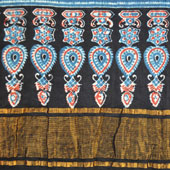Design Resource
Ajarakh
The Crafts of Traditional Motifs and Colors
by
Prof. Bibhudutta Baraland Antony William
1. The fabric is washed in Harda and dried for a day in an open place with good sunlight. Once the cloth is dried it is mounted on the block-printing table. The wooden block with design motifs carved on it are dipped in the solution of Gum Arabic and Lime and placed on the fabric to make desired pattern. This process is repeated on the other side of the fabric making it a two-sided print. There are also fabrics which are printed only on one side like stoles, scarves etc. The purpose or the use aspect of the fabric is decided before hand and cut and designed accordingly.
2. Printing involves 3-4 blocks per motif. For example if a flower motif has to be printed one would require 3 blocks. The first one containing the outline of the flower. (Usually using alum or resist solution), the 2nd the inner parts of petals. And 3rd the center of the flower. Depending on the complexity of the pattern the number of blocks are decided. Usually the number of blocks is four. The printing starts with the outline block followed by the other blocks dipped in various dyes that fill in various parts of the motif. The printed fabric is kept overnight and dyed in the desired color the next day and dried.
3. The printed fabric is kept for drying overnight. It is then dyed in the desired colors and sun dried.
4. To get richer or new colors the process repeats starting from the application of Alum and clay.
5. During the dying process the fabric is dyed in the boiling water along with either Rhubarb root (crimson red), Medder Root (red), Henna Powder (sap green), Dhavadi Flowers (orange) or Alizarin (yellow) to get the desired color in the inner parts of motif. The areas on which alum is applied does not react with these coloring agents and remains the same (The color of the petals in the above example). The temperature of the boiling water is decided on the basis of the nature of the fabric. Cotton requires lower temperature where as silk requires higher temperatures.
6. The washed fabric is dried in open space.























